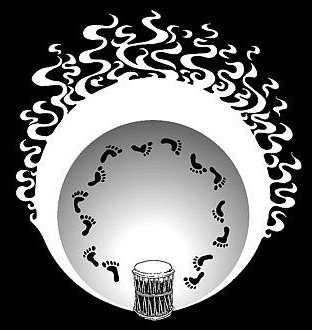GUIDELINES FOR COUNCIL
A form of the Council or Talking Circle has been used by many Native American tribes on this continent, and by indigenous peoples throughout the world. The specific process described here has been developed by Earth Drum Council, based on Native teachings and influenced by modern facilitation techniques. To quote the Guidelines to Council Circles written by the organizers of Earth Day 1993, "We chose a process that we believe reflects... the spirit of our initial consensus to honor native people, while also providing the greatest opportunity for all people to express their beliefs [and] concerns... Rather than opposition, argument, and debate, the council gives equal weight to all points of view."
IN OUR TRADITION ARE AS FOLLOWS:
• Participants are gathered in a circle, so that all have equal standing, and can hear and see each other.
• A talking piece is used, which is the true "facilitator" of the Council. We most often use a feather as a talking piece, but another object may be used. We can think of this object as the "listening piece." Its holder is due the respectful listening of everyone in the circle.
• The obligation of the person holding the feather is to speak from the heart, not from the head. This means that pre-written speeches are not appropriate in Council.
• The obligation of those in the circle is to stay present and give the person speaking their full attention. This means not rehearsing what one is going to say, or making note of points to respond to later. It also means not interrupting or engaging in back-and-forth dialogue.
• The role of the human facilitator or co-facilitators of the Council is to be the guardian of the process and servant to the circle. Aspects of this role include timekeeping, vibeswatching, and clarifying the process. The facilitator(s) determines the method of passing the talking piece (i.e., popcorn or round). The facilitator(s) may interrupt to remind the circle of process agreements, or ask for a pause to realign ourselves with our intentions. To honor their responsibility to the circle, facilitators do not express their own point of view in Council (although exceptions to this may be made in certain circumstances).
SOME OF THE TRADITIONS WE HAVE DEVELOPED ARE:
• Before Council begins, we smudge the circle with sage smoke. Individuals may decline to be smudged.
• The "twinkle" or wiggling fingers, adapted from the deaf community, is a way of signaling agreement or resonance with what a person is saying without interrupting.
• If you must leave the Council temporarily, a personal token left on your chair will "hold your place" until you return.
• After each person has finished speaking, we take a breath before continuing, to fully absorb what the last speaker has shared.
Councils may be called for many purposes, including preparing to make decisions, considering issues, resolving conflicts, and heartsong. The Council sessions at EDC Weekend have the primary purpose of witnessing the variety of perspectives in the community about our common purpose and future, and thus providing information that we can use in decision-making.
A word about time: In many indigenous traditions, Council continued until every person had spoken as long as they needed and the talking piece went around once in silence. One of the concessions we must make to the "modern" world is the need to operate by the clock. We acknowledge the limitations this imposes on the process. We ask that you respect the time limits established by the facilitators, so that everyone will have the opportunity to be heard during the scheduled Council period.

